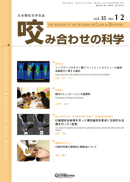Volume 35, Issue 1-2
Displaying 1-11 of 11 articles from this issue
- |<
- <
- 1
- >
- >|
-
2015 Volume 35 Issue 1-2 Pages 13-19
Published: April 25, 2015
Released on J-STAGE: June 17, 2016
Download PDF (754K)
-
2015 Volume 35 Issue 1-2 Pages 20-30
Published: April 25, 2015
Released on J-STAGE: June 17, 2016
Download PDF (2266K) -
2015 Volume 35 Issue 1-2 Pages 31-37
Published: April 25, 2015
Released on J-STAGE: June 17, 2016
Download PDF (1293K) -
2015 Volume 35 Issue 1-2 Pages 38-48
Published: April 25, 2015
Released on J-STAGE: June 17, 2016
Download PDF (1439K)
-
2015 Volume 35 Issue 1-2 Pages 49-56
Published: April 25, 2015
Released on J-STAGE: June 17, 2016
Download PDF (1374K) -
2015 Volume 35 Issue 1-2 Pages 57-62
Published: April 25, 2015
Released on J-STAGE: June 17, 2016
Download PDF (1125K) -
2015 Volume 35 Issue 1-2 Pages 63-72
Published: April 25, 2015
Released on J-STAGE: June 17, 2016
Download PDF (1148K) -
2015 Volume 35 Issue 1-2 Pages 73-81
Published: April 25, 2015
Released on J-STAGE: June 17, 2016
Download PDF (1762K)
-
2015 Volume 35 Issue 1-2 Pages 82-87
Published: April 25, 2015
Released on J-STAGE: June 17, 2016
Download PDF (2237K) -
2015 Volume 35 Issue 1-2 Pages 88-93
Published: April 25, 2015
Released on J-STAGE: June 17, 2016
Download PDF (1172K) -
2015 Volume 35 Issue 1-2 Pages 94-97
Published: April 25, 2015
Released on J-STAGE: June 17, 2016
Download PDF (919K)
- |<
- <
- 1
- >
- >|
